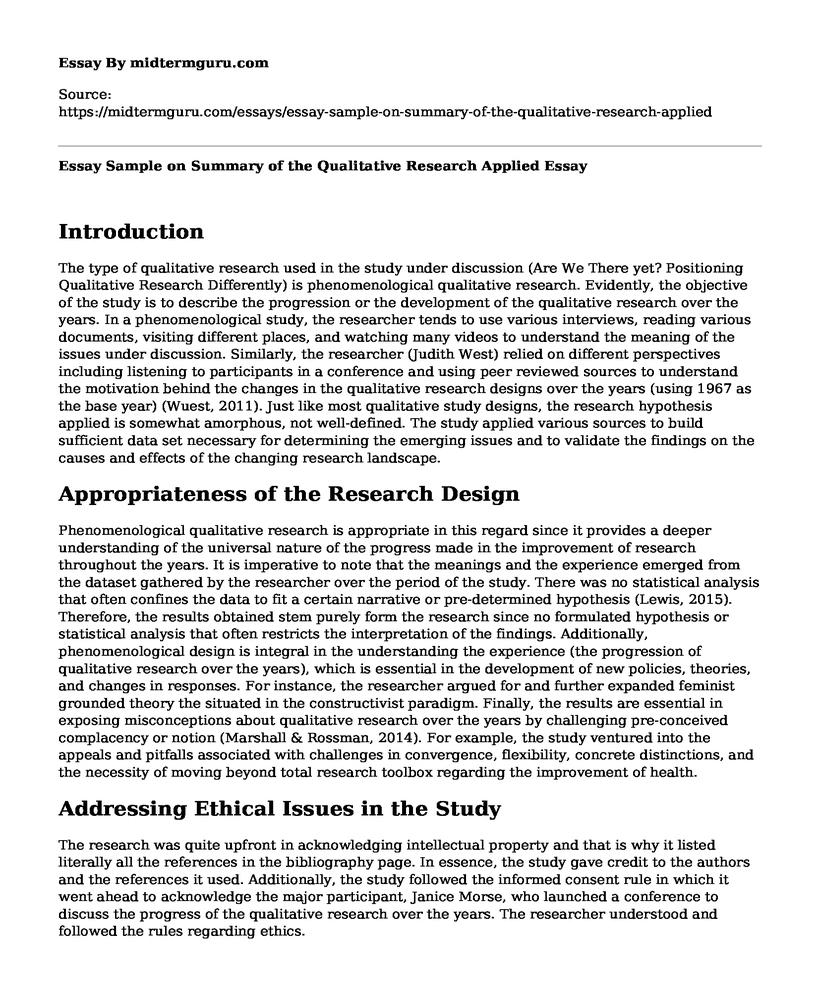Introduction
The type of qualitative research used in the study under discussion (Are We There yet? Positioning Qualitative Research Differently) is phenomenological qualitative research. Evidently, the objective of the study is to describe the progression or the development of the qualitative research over the years. In a phenomenological study, the researcher tends to use various interviews, reading various documents, visiting different places, and watching many videos to understand the meaning of the issues under discussion. Similarly, the researcher (Judith West) relied on different perspectives including listening to participants in a conference and using peer reviewed sources to understand the motivation behind the changes in the qualitative research designs over the years (using 1967 as the base year) (Wuest, 2011). Just like most qualitative study designs, the research hypothesis applied is somewhat amorphous, not well-defined. The study applied various sources to build sufficient data set necessary for determining the emerging issues and to validate the findings on the causes and effects of the changing research landscape.
Appropriateness of the Research Design
Phenomenological qualitative research is appropriate in this regard since it provides a deeper understanding of the universal nature of the progress made in the improvement of research throughout the years. It is imperative to note that the meanings and the experience emerged from the dataset gathered by the researcher over the period of the study. There was no statistical analysis that often confines the data to fit a certain narrative or pre-determined hypothesis (Lewis, 2015). Therefore, the results obtained stem purely form the research since no formulated hypothesis or statistical analysis that often restricts the interpretation of the findings. Additionally, phenomenological design is integral in the understanding the experience (the progression of qualitative research over the years), which is essential in the development of new policies, theories, and changes in responses. For instance, the researcher argued for and further expanded feminist grounded theory the situated in the constructivist paradigm. Finally, the results are essential in exposing misconceptions about qualitative research over the years by challenging pre-conceived complacency or notion (Marshall & Rossman, 2014). For example, the study ventured into the appeals and pitfalls associated with challenges in convergence, flexibility, concrete distinctions, and the necessity of moving beyond total research toolbox regarding the improvement of health.
Addressing Ethical Issues in the Study
The research was quite upfront in acknowledging intellectual property and that is why it listed literally all the references in the bibliography page. In essence, the study gave credit to the authors and the references it used. Additionally, the study followed the informed consent rule in which it went ahead to acknowledge the major participant, Janice Morse, who launched a conference to discuss the progress of the qualitative research over the years. The researcher understood and followed the rules regarding ethics.
How the Study Would Be Different if It Used Quantitative Design
The study mainly relied on narration to explore the advances of research. On the other hand, quantitative research would majorly rely on numerical data that is easily transformed into applicable statistics. In this regard, the study would quantify attitudes, behaviors, opinions, and other defined variables from the sampled population (Yilmaz, 2015). It is imperative to note that quantitative research applies measurable data to uncover patterns and to formulate facts. Moreover, the methods used in data collection are more structured when compared to the methods used in qualitative research.
References
Lewis, S. (2015). Qualitative inquiry and research design: Choosing among five approaches. Health Promotion Practice, 16(4), 473-475.
Marshall, C., & Rossman, G. B. (2014). Designing Qualitative Research. Sage publications.
Wuest, J. (2011). Are we there yet? Positioning Qualitative Research Differently. Qualitative Health Research, 21(7), 875-883.
Yilmaz, K. (2013). Comparison of Quantitative and Qualitative Research Traditions: Epistemological, Theoretical, and Methodological Differences. European Journal of Education, 48(2), 311-325.
Cite this page
Essay Sample on Summary of the Qualitative Research Applied. (2022, Nov 06). Retrieved from https://midtermguru.com/essays/essay-sample-on-summary-of-the-qualitative-research-applied
If you are the original author of this essay and no longer wish to have it published on the midtermguru.com website, please click below to request its removal:
- Application for a Job as a Quality Analyst
- MBA Final Project Preparation: Qualitative and Quantitative Research
- Statistical Process Capability - Essay Sample
- Comparing Statistics of the US and Greece Health Care System - Paper Example
- Paper Example on Theoretical Foundation and Conceptual Framework
- Workplace Incivility: A Growing Challenge in Our Organization - Essay Sample
- Research Protocol: Design, Plan, & Ethically Approve - Research Paper







